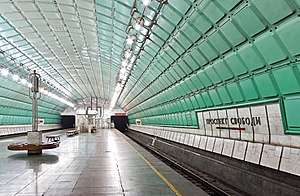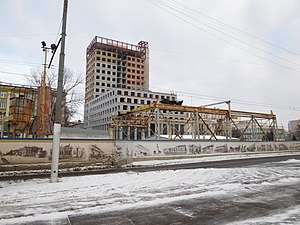Dnipro Metro
The Dnipro Metro (Ukrainian: Дніпровський метрополітен; Russian: Днепровский метрополитен) is a single-line rapid transit system that serves the city of Dnipro, the fourth largest city in Ukraine by population.[6] The metro was the fourth system constructed in Ukraine, after the Kiev , Kharkiv and Kryvyy Rih metro systems, respectively, when it opened on December 29, 1995. The metro was the fifteenth built in the former Soviet Union region, and the first to open after the collapse of the Soviet Union in 1991.
 | |||
 | |||
| Overview | |||
|---|---|---|---|
| Native name | Дніпровський метрополітен Dniprovskyi metropoliten | ||
| Owner | City of Dnipro, Department of Transport and Transport Infrastructure | ||
| Locale | Dnipro, Ukraine | ||
| Transit type | Rapid transit | ||
| Number of lines | 1[1] | ||
| Number of stations | 6[1] | ||
| Daily ridership | 20.4 thousand (2016) [2] | ||
| Annual ridership | 7.45 million (2016)[3] | ||
| Website | metro | ||
| Operation | |||
| Began operation | December 29, 1995 | ||
| Operator(s) | Dniprovskyi metropoliten | ||
| Number of vehicles | 45 (2013)[4] | ||
| Headway | 7–17 minutes[5] | ||
| Technical | |||
| System length | 7.1 km (4.4 mi)[1] | ||
| Track gauge | 1,524 mm (5 ft) | ||
| |||
The Dnipro Metro consists of one 7.1-kilometer (4.4 mi) line and 6 stations.[1] The line starts at the Vokzalna station, near the city's central railway station in the east and ends at the Pokrovska station in the western part of the city. The system is open from 05:30 to 23:00.[5] Ridership on the metro has steadily declined since its opening in 1995;[2] in 2013, the metro carried only 7.51 million passengers[1] (compared to 18.2 million in 1995[2]). Initially, the metro trains carried five train cars each, but as the passenger ridership declined, the number of cars was reduced to three.[7] The price for a single ride is currently 6 UAH; either plastic token or transit cards are used at the entrance gates.
Current expansion plans are projected to increase the number of stations to nine by 2023.[8]
History
With the help from the First Secretary of the Central Committee of the Communist Party of Ukraine Vladimir Shcherbitsky, in 1979 the Council of Ministers of the Soviet Union affirmed the Central Committee of the Communist Party's action to allow the Gosplan (government planning agency) and the communication and transportation construction ministries to conduct research on construction a metropolitan system in Dnipropetrovsk.[9][10] In 1980, four lines were planned with one line parallel to the Dnieper with nine stations: Kommunarov, Prospect Sovobdy, Mayakovskaya, Vozrozhdenie, Kalininskaya, Petrovsky Square, Teatralna, Lenin Square and "Student".[11] The second line was planned to pass through residential areas and industrial enterprises of the southern right-bank part of the city, Lenin Square and residential areas on the left bank of the Dnieper.[11] The third should have connected through "the center quarters of the southwestern part with the north on the left bank of the Dnieper."[11] The fourth should have run along the left bank and cross residential areas and industrial areas of the northern part of the city.[11] After the Teatralna, Tsentralna, and Muzeina will be completed the first metro line of Dnipro as it was envisioned in 1980 will be completed, in November 2018 city authorities expected these three new stations to be opened by the summer of 2023.[8]



On March 15, 1982 following a decree by the Council of Ministers of the Soviet Union[12] the Dnipro Metro was included in the list of first priority construction projects.[10] It was planned to finish it by the 12th five-year plan.[10] But soon after the death of Leonid Brezhnev on 10 November 1982 in the country ended up in economic hardship and financing of the project was reduced.[10] In 1988 Mikhail Gorbachev when was visiting the city promised the residents to help with finishing of the projects, yet his promises were left unrealized.[10] With dissolution of the Soviet Union, the projected was halted.[10] In 1994 it was decided to force the completion of the project and with the help of the chairman of regional council Pavlo Lazarenko these plans were realised when the system's first line, the Tsentralno-Zavodska Line, was opened to the public on December 29, 1995.[10]
The Dnipro Metro system was constructed following the typical Soviet metro construction format. Out of the six stations, five are located deep underground and one is placed near the surface. Four of the deep stations are single vaults built on Leningrad technology and one is a Pylon. The only shallow station is a pillar trispan. Owing to the economic recession of the early 1990s, the metro stations lack the same level of decoration and architectural integrity of those built in Soviet times.
Future growth
Three stations are currently under construction, which would expand the system from the Dnipro Central Railway Station (at Vokzalna) to the city centre; Teatralna (near the Theatre of Opera and Ballet), Tsentralna, and Muzeina (near the Museum of History).[5] Construction on these three stations was restarted in late February 2011 after being completely halted on July 26, 2009.[13] A lack of funding for the construction also was due to the fact that Dnipropetrovsk was not chosen as one of the host cities of the UEFA Euro 2012 football championship.

In June 2014, President Petro Poroshenko signed the 2014 budget into law which will allocate funding to the "Dnipropetrovskyi Metropoliten" company for the completion of the metro's line.[14] The two new stations in the city centre, Teatralna and Tsentralna, were expected to be finished by 2015, whilst Muzeina was according to plans to be finished by 2016.[5] Another station, "Parus", is planned for the western terminus of the Tsentralno-Zavodska Line.[5] But construction did not start because the tender to select the contractor was stopped by the city council in August 2015.[15] In summer of 2016, the mayor of Dnipro Borys Filatov and representatives of the Limak Holding signed a contract to build the Dnipro subway.[16] The active phase of works started in April of 2017.[16] In November 2018, city authorities expected the three new stations to be opened by the summer of 2023.[8] In the beginning of 2019, it was announced that there were allocated some 1.4 billion (hryvnias) as a subvention from state budget.[16]
After the first additions to the line segment, the total length of the only line is expected to be 11.82 kilometers (7.34 mi), with 9 stations.[5] In the long term perspective, a second line is planned to span across the River Dnieper, and to potentially have 80 kilometers (50 mi) of track on three lines minimum.[5]
See also
References
- ОСНОВНЫЕ ТЕХНИКО-ЭКСПЛУАТАЦИОННЫЕ ХАРАКТЕРИСТИКИ МЕТРОПОЛИТЕНОВ ЗА 2013 ГОД. [Main technical and operational specifications for Subways for Year 2013.] (pdf). asmetro.ru (in Russian). Международная Ассоциация "Метро" [International Association of Metros]. 2013. pp. 1, 3. Retrieved 2014-05-13.
- Відправлення (перевезення) пасажирів за видами транспорту загального користування [Departure (transport) of passengers by public transport] (in Ukrainian). Головне управління статистики у Дніпропетровській області [Department of Statistics in the Dnipropetrovsk region]. Archived from the original on 2014-02-01. Retrieved 2014-05-17.
- "Пасажирські перевезення за 2016 рік" (PDF). Головне управління статистики у Дніпропетровській області.
- Kostyuk, Artyom. "Rolling track". dpmetro.narod.ru (in Russian). Retrieved 2008-06-21.
- "Information about the metro system". gorod.dp.ua. Dnipropetrovsk City Central Internet Portal. Retrieved 2014-05-17.
- "About number and composition population of UKRAINE by All-Ukrainian Population Census'2001 data". All-Ukrainian population census 2001. State Statistics Committee of Ukraine. Archived from the original on 2006-01-09. Retrieved 2008-06-21.
- "Dnipropetrovsk Metro". UrbanRail.net. Archived from the original on 2008-06-04. Retrieved 2008-06-21.
- (in Ukrainian) Dniprovsky City Council plans to open 3 new subway stations by summer 2023, Ukrainian News Agency (22 November 2018)
- Platonov, Vladimir (December 30-January 5, 1996). "Metro as a secret object and symbol of the highest patronage". Zerkalo Nedeli (in Russian). Archived from the original on 2007-07-16. Retrieved 2008-06-21. Check date values in:
|date=(help) - Goldman, Yevgeniy (2018-11-30). "Under rumble of railtracks and in the darkness of tunnels: get to know how was built the Dnipro Metro". Nashe Misto (in Russian). Retrieved 2019-04-29.
- (in Russian) The metro is being designed in Dnepropetrovsk (Metrostroy magazine No.5 1980), Dnipro Metropoliten (unfficial website of Dnipro Metro)
- "Dnipropetrovskyi metropoliten". Ministry of Transport and Communications of Ukraine (in Ukrainian). Retrieved 2008-06-21.
- "In Dnipropetrovsk construction is restarted on the metro". Korrespondent.net (in Russian). February 28, 2011. Retrieved 2011-05-16.
- "Poroshenko allocated funding towards finishing the Dnipropetrovsk Metro". Ekonomichna Pravda (in Ukrainian). Ukrayinska Pravda. 6 July 2014. Retrieved 6 July 2014.
- (in Ukrainian) The metro is not being built in Dnipropetrovsk because Filatov and Korban require "kickbacks", - Pashchenko, Ukrainian News Agency (17 August 2015)
- Finishing of the subway is one of the most important and the biggest dynamic projects of Dnipro (Добудова метрополітену – один із найважливіших та найбільш динамічних проектів Дніпра). Dnipro Metro website. 7 February 2019
External links
| Wikimedia Commons has media related to Dnipro Metro. |
- Dnipro Metro – unofficial website (in Ukrainian)
- Dnipro Metro at Metroworld website (in Russian and English)
- Dnipro Metro at UrbanRail.net
- Dnipro Metro at Subways.net
- Daryna Sukhonis. What mysteries hides the Dnipro Metro (photos) (Які таємниці ховає дніпровський метрополітен (Фото)). Visti Prydniprovia. 9 November 2016
- Olga Fomenko. How the Dnipro Metro masters the budget on purchases of expensive non-operational equipment (Как днепровский метрополитен осваивает бюджет на закупках дорогого, но неработающего оборудования). Anti-corr. 27 February 2019
- Yegor Moroz. Subway of Dnipro: old and new. How and for how much it is repaired and built? (Метро Днепра: старое и новое. Как и за сколько ремонтируют и строят?). 49000.com. 26 April 2018
